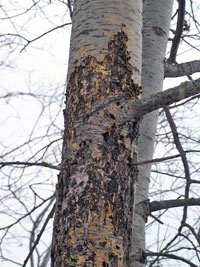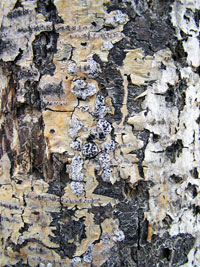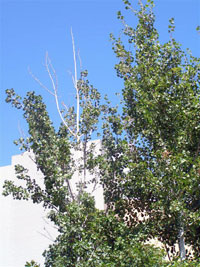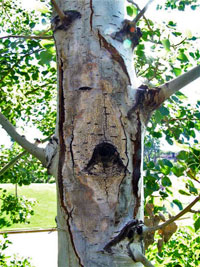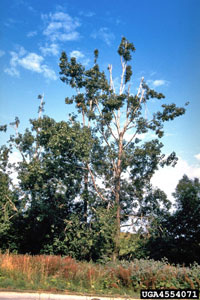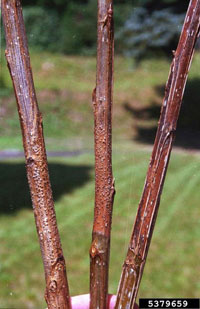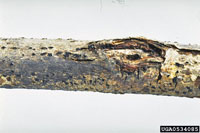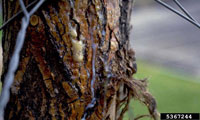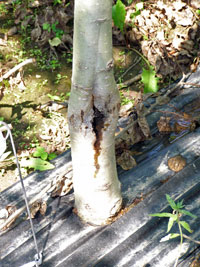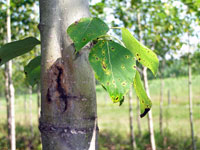Extension > Garden > Diagnose a problem > What's wrong with my plant? > Deciduous Trees > Poplar > Discolored bark on branch or trunk
Poplar > Trunk/Branches > Discolored bark on branch or trunk
1 of 5
Hypoxylon canker
Entoleuca mammata
- Leaves on one or more branches are undersized, turn yellow then to brown and remain attached to stem
- Cankers begin near wounds or at the base of a branch
- Infected bark initially turns yellowish-orange; older infections are black at center with yellowish-orange margins
- Bark first appears blistered and raised, then falls off to reveal blackened wood
- Clusters of raised buff white to black bump like fungal stromata can be seen on 3 year old cankers
- Damage most common on trembling aspen
Management
- There are no fungicides that prevent or cure Hypoxylon canker.
- Avoid planting species that can become infected where existing Hypoxylon infections are found on neighboring trees.
- Prune to remove dead or dying branches during dry periods, before the canker reaches the main trunk.
- Remove structurally weak trees that have cankers along the main trunk in order to avoid damage to people and property from tree breakage.
2 of 5
Valsa and Leucostoma cankers
Valsa sordida and Leucostoma niveum
- Random dead branches seen throughout canopy
- Sunken irregularly-elongated cankers with cracked bark at the edges occur on branches or the main trunk
- Leaves on random branches wilt, turn yellow then brown
- Cankers are brown to black at the center with salmon to orange discoloration of the bark at the edges
- In wet weather curled tendrils of orange spores emerge from pimple like fungal structures within infected branches
- Common on trees stressed by drought, winter injury, wounds, insect feeding or other factors
- More information on canker
3 of 5
Cryptodiaporthe canker
Cryptodiaporthe populea
- Multiple thin weak adventitious shoots develop
- Bark on cankers may or may not be discolored, but the tissue beneath the bark will be brown to black
- Callus tissue formed around edges of cankers causing bark to fall off and expose the wood beneath it
- Leaves on infected branches turn yellow and drop prematurely
- Random dead branches caused from girdling cankers seen throughout canopy
- Common on Lombardy poplars
4 of 5
Wetwood or bacterial slime flux
Several species of bacteria
- Streaks/columns of water-soaked bark discoloration on the trunk or branches that is gray to yellow-brown when dry and black to brown when wet
- Discoloration commonly starts at bark cracks, wounds, or branch unions
- Fluid may ooze or bleed out of openings in the bark and may have a yeast-like odor
- More information on wetwood
5 of 5
Leaf spot and canker blights
Marssonina spp., Septoria spp., Colletotrichum
gloeosporioides
- Dark, sunken cankers can develop on stems of Septoria infected
- Irregular dark spots (angular to round) to large blotches on leaf surface
- Severe infestations may lead to leaf yellowing full defoliation by late summer
- Lower branches are infected first
- More information on Leaf spot and canker blights




